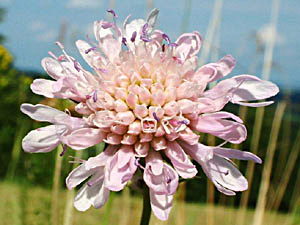
medicinal herbs
Field Scabious
Knautia arvensis

Herb: Field Scabious
Latin name: Knautia arvensis
Synonyms: Scabiosa arvensis
Family: Dipsacaceae (Teasel Family)
Medicinal use of Field Scabious:
The whole plant is astringent and mildly diuretic. An infusion is used internally as a blood purifier and externally for treating cuts, burns and bruises. The fresh or dried flowering plant can be used, with or without the roots. A homeopathic remedy is made from the plant. It is used as a blood purifier and as a treatment for eczema and other skin disorders.Description of the plant:

Plant:
Perennial
Height:
100 cm(3 1/4 foot)

Flowering:
July toSeptember
Habitat of the herb:
Meadows, pastures, hedgebanks and grassy hills, usually on dry soils and especially on limestone.Propagation of Field Scabious:
Seed - sow spring or autumn in a cold frame. When they are large enough to handle, prick the seedlings out into individual pots and plant them out in the summer. If you have enough seed it would be worthwhile trying a sowing in situ outdoors in the spring. The seed germinates in the spring in the wild. Division in the spring. Basal cuttings in late spring. Harvest the shoots when they are about 10 - 15cm long with plenty of underground stem. Pot them up into individual pots and keep them in light shade in a cold frame or greenhouse until they are rooting well. Plant them out in the summer.Cultivation of the herb:
Meadows, pastures, hedgebanks and grassy hills, usually on dry soils and especially on limestone.Known hazards of Knautia arvensis:
None knownPlant information taken from the Plants For A Future.
